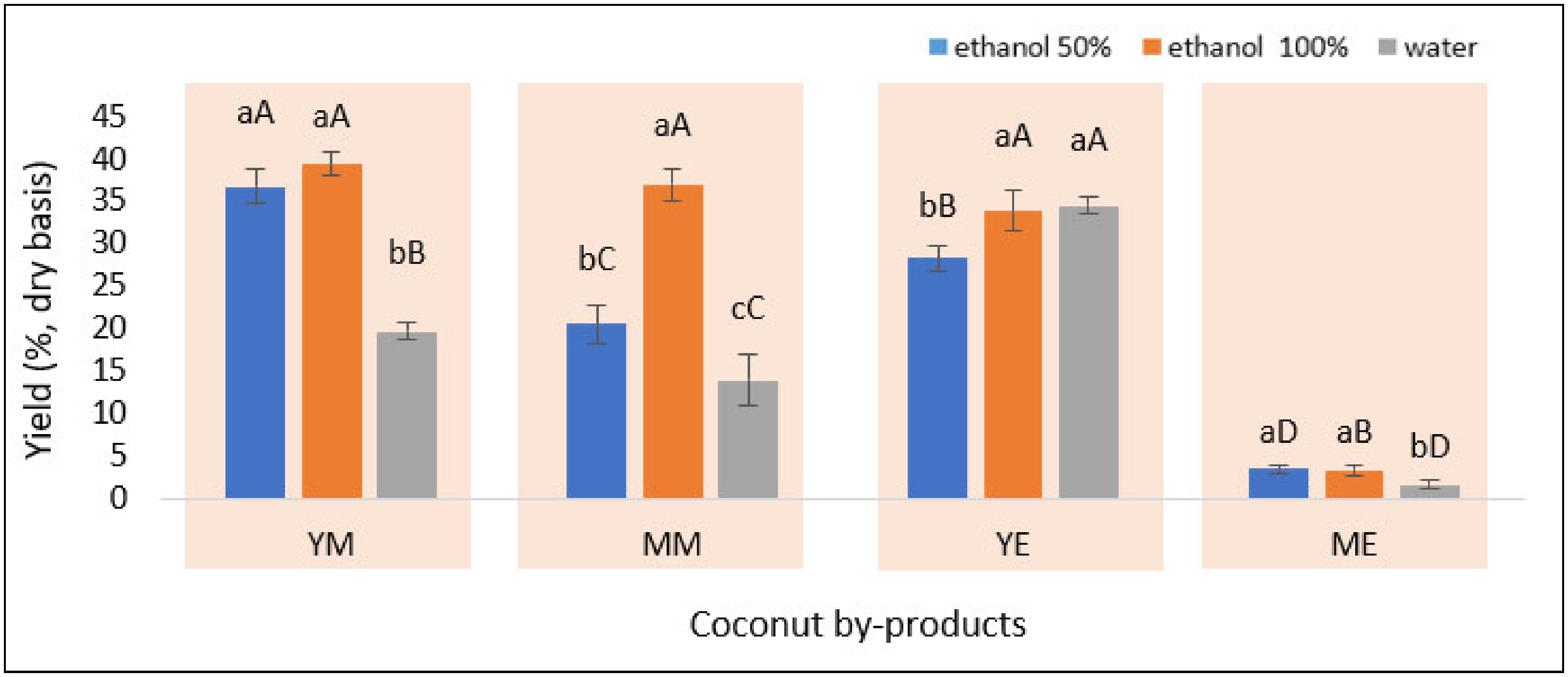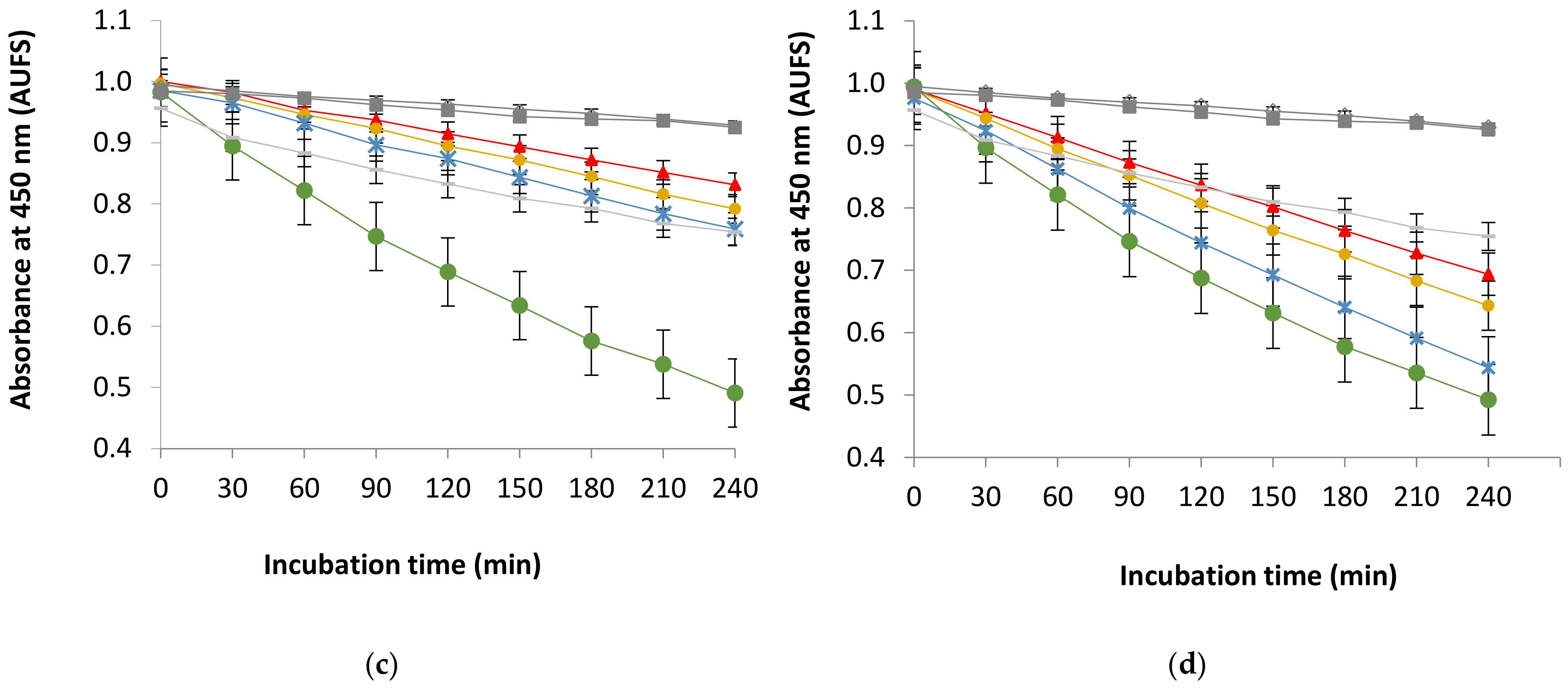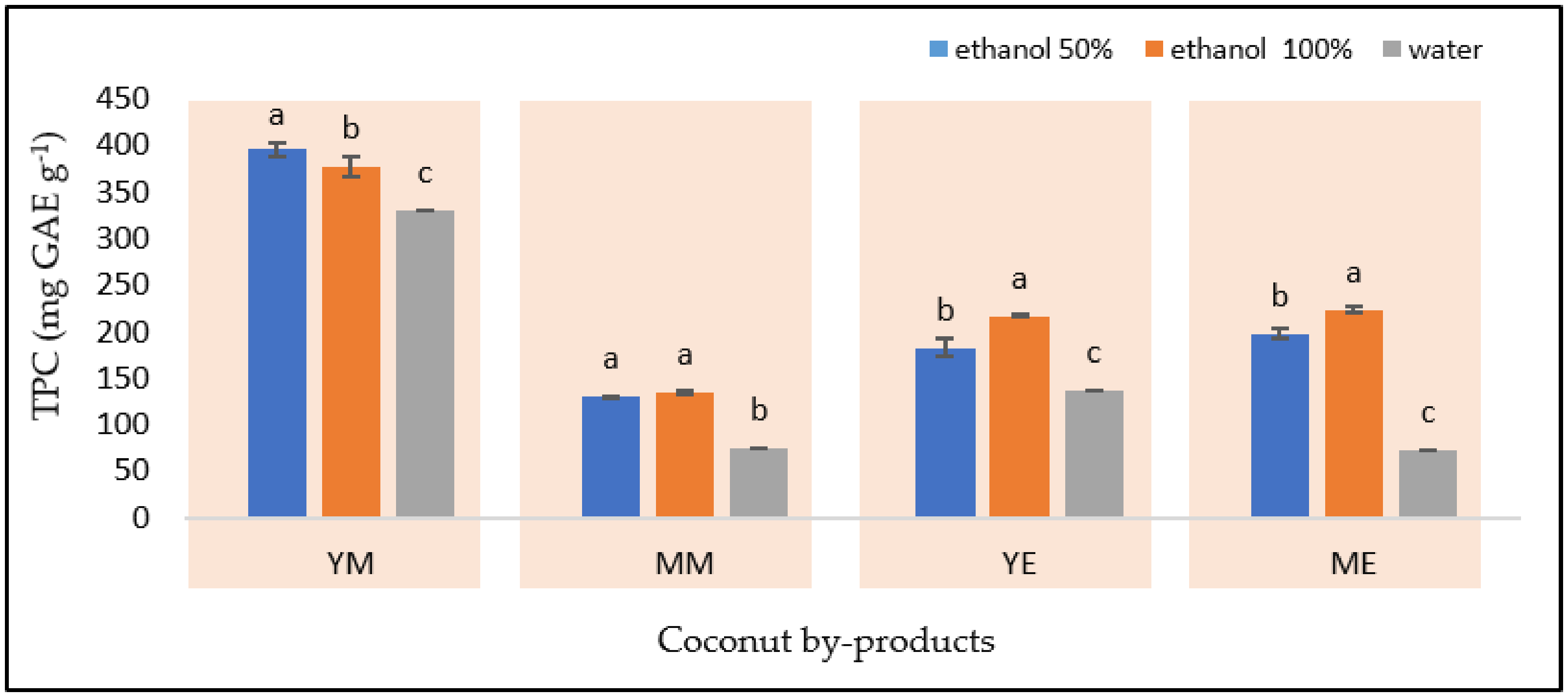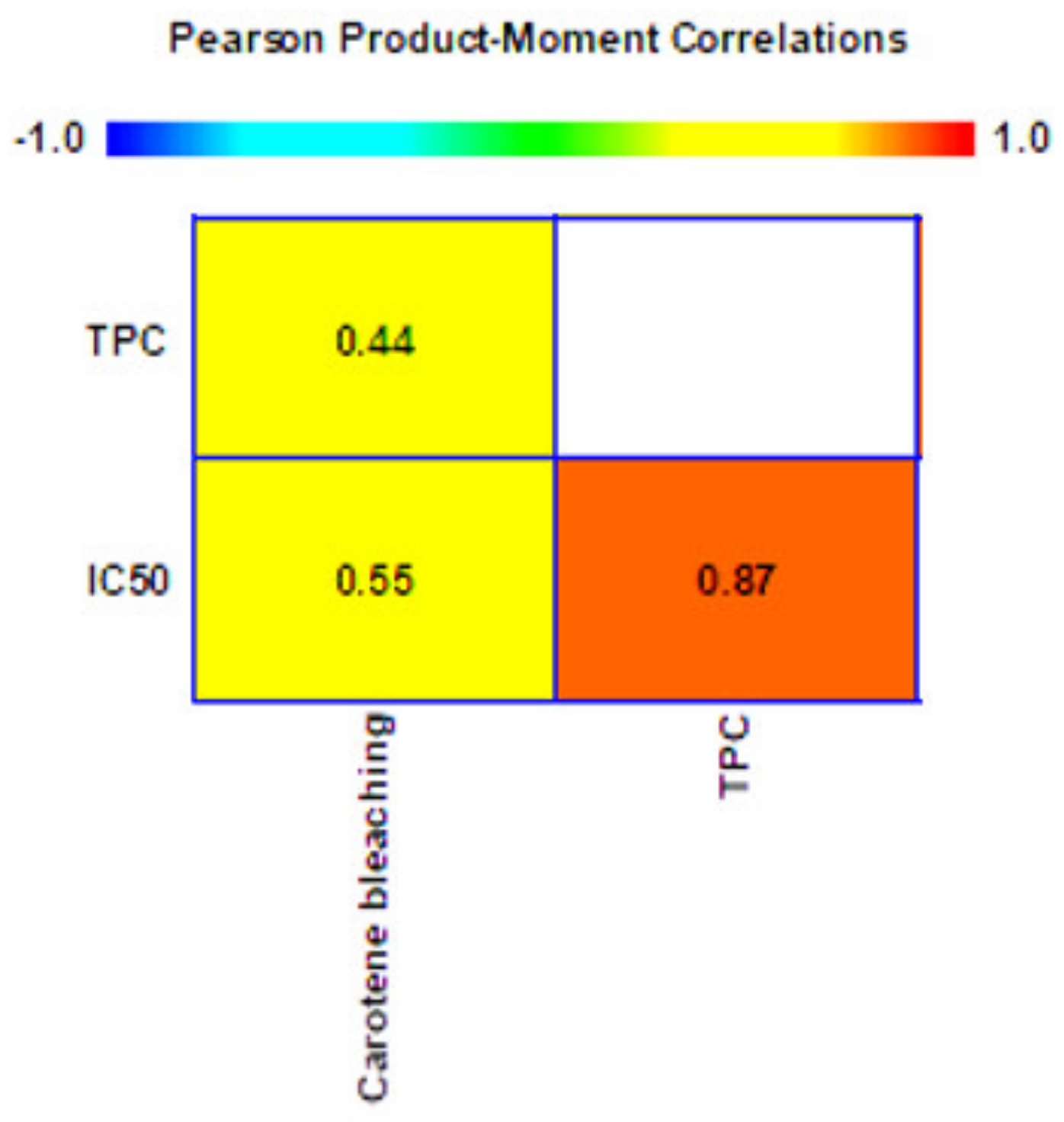Antioxidant Activity of Aqueous and Ethanolic Extracts of Coconut (Cocos nucifera) Fruit By-Products
Abstract
:1. Introduction
2. Materials and Methods
2.1. Materials
2.2. Sample Preparation
2.3. Ultrasound-Assisted Extraction
2.4. Antioxidant Activity
2.4.1. 2,2-Diphenyl-1-Picrylhydrazyl (DPPH)-Radical Scavenging Activity (RSA) Assays
2.4.2. β-Carotene-Linoleic-Acid System Assay
2.5. Total Phenolic Compounds Determination
2.6. Individual Phenolic Compounds Identification
2.7. Statistical Analysis
3. Results and Discussion
3.1. Effect of the Sample Matrices and Solvent on the Extraction Yield
3.2. Effect of the Sample Matrices and Solvent on the Antioxidant Activities
3.2.1. DPPH Radical Scavenging Activity
3.2.2. Linoleic-Acid-β-Carotene Bleaching System
3.3. Effect of the Sample Matrices and Solvent on the Phenolic Compounds
3.4. Correlation between Total Phenolic Compounds and Antioxidant Activities
4. Conclusions
Author Contributions
Funding
Institutional Review Board Statement
Informed Consent Statement
Data Availability Statement
Acknowledgments
Conflicts of Interest
References
- Adekola, K.A.; Salleh, A.B.; Zaidan, U.H.; Azlan, A.; Chiavaro, E.; Paciulli, M. Total phenolic Content, Antioxidative and Antidiabetic Properties of Coconut (Cocos Nucifera L.) Testa and Selected Bean Seed Coats. Ital. J. Food Sci. 2017, 29, 741–753. [Google Scholar] [CrossRef]
- Akhter, A.; Zaman, S.; Ali, U.; Ali, Y.; Miah, M.A.J. Isolation of Polyphenolic Compounds from the Green Coconut (Cocos Nucifera) Shell and Characterization of Their Benzoyl Ester Derivatives. J. Sci. Res. 2009, 2, 186–190. [Google Scholar] [CrossRef] [Green Version]
- Appaiah, P.; L., S.; A. G., G.K.; G., S.K. Phytochemicals and Antioxidant Activity of Testa Extracts of Commercial Wet and Dry Coconuts and Cakes. Int. Res. J. Pharm. 2016, 7, 9–13. [Google Scholar] [CrossRef]
- Arivalagan, M.; Roy, T.K.; Yasmeen, A.M.; Pavithra, K.C.; Jwala, P.N.; Shivasankara, K.S.; Manikantan, M.R.; Hebbar, K.B.; Kanade, S.R. Extraction of Phenolic Compounds with Antioxidant Potential from Coconut (Cocos Nucifera L.) Testa and Identification of Phenolic Acids and Flavonoids Using UPLC Coupled with TQD-MS/MS. LWT-Food Sci. Technol. 2018, 92, 116–126. [Google Scholar] [CrossRef]
- Onyechi, O.; Elijah, P.; Nkechi, J. Available Online through Phytochemical Analysis of Cocos Nucifera L. J. Pharm. Res. 2010, 3, 280–286. [Google Scholar]
- Kibria, A.A.; Nessa, K.; Rahman, M.M. Extraction and Evaluation of Phytochemicals From Green Coconut (Cocos Nucifera) Shell. Malays. J. Halal Res. J. 2018, 1, 19–22. [Google Scholar] [CrossRef]
- Chakraborty, M.; Mitra, A. The Antioxidant and Antimicrobial Properties of the Methanolic Extract from Cocos Nucifera Mesocarp. Food Chem. 2008, 107, 994–999. [Google Scholar] [CrossRef]
- Silva, R.R.; e Silva, D.O.; Fontes, H.R.; Alviano, C.S.; Fernandes, P.D.; Alviano, D.S. Anti-Inflammatory, Antioxidant, and Antimicrobial Activities of Cocos Nucifera Var. Typica. BMC Complementary Altern. Med. 2013, 13, 107. [Google Scholar] [CrossRef] [Green Version]
- Valadez-carmona, L.; Cortez-Garcia, R.M.; Plazola-Jacinto, C.P.; Ortiz-Moreno, A.; Necoechea-Mondrago, H. Effect of Microwave Drying and Oven Drying on the Water Activity, Color, Phenolic Compounds Content and Antioxidant Activity of Coconut Husk (Cocos nucifera L.). J. Food Sci. Technol. 2016, 53, 3495–3501. [Google Scholar] [CrossRef] [Green Version]
- Elsbaey, M.; Abdel, B.F.M. Coconut Waste as a Potential Source for Cytotoxic and Antioxidant Compounds. Int. J. Pharmacogn. Phytochem. Res. 2017, 9, 1288–1292. [Google Scholar] [CrossRef] [Green Version]
- Solangi, A.H.; Iqbal, M.Z. Chemical Composition of Meat (Kernel) and Nut Water of Major Coconut (Cocos nucifera L.) Cultivars at Coastal Area of Pakistan. Pak. J. Bot. 2011, 43, 357–363. [Google Scholar]
- Dey, G.; Sachan, A.; Ghosh, S.; Mitra, A. Detection of Major Phenolic Acids from Dried Mesocarpic Husk of Mature Coconut by Thin Layer Chromatography. Ind. Crop. Prod. 2003, 18, 171–176. [Google Scholar] [CrossRef]
- Perera, C.; Meegahakumbura, M.K.; Dissanayaka, A.C.; Perera, L. Quantitative Characterization of Nut Yield and Fruit Components in Quantitative Characterization of Nut Yield and Fruit Components in Indigenous Coconut Germplasm in Sri Lanka. Int. J. Biodivers. 2014. [Google Scholar] [CrossRef] [Green Version]
- Kalina, S.; Navaratne, S.B. Analysis of Antioxidant Activity and Texture Profile of Tender-Young and King Coconut (Cocos Nucifera) Mesocarps under Different Treatments and the Possibility to Develop a Food Product. Int. J. Food Sci. 2019, 1, 1–7. [Google Scholar] [CrossRef] [Green Version]
- Figueira, N.T.; Santos, R.M.; Campesatto, E.A.; Lúcio, I.M.L.; De Araújo, E.C.; Bastos, M.L.D.A. Review Article Biological Activity of the Cocos Nucifera L. and Its Profile in the Treatment of Diseases: A Review. J. Chem. Pharm. Res. 2013, 5, 297–302. [Google Scholar]
- Bhagya, D.; Prema, L.; Rajamohan, T. Therapeutic Effects of Tender Coconut Water on Oxidative Stress in Fructose Fed Insulin Resistant Hypertensive Rats. Asian Pac. J. Trop. Med. 2012, 5, 270–276. [Google Scholar] [CrossRef] [Green Version]
- Preetha, P.P.; Devi, V.G.; Rajamohan, T. Hypoglycemic and Antioxidant Potential of Coconut Water in Experimental Diabetes. Food Funct. 2012, 3, 753–757. [Google Scholar] [CrossRef]
- Geetha, V.; Bhavana, K.P. Studies on the Composition and In-Vitro Antioxidant Activities of Concentrates from Coconut Testa and Tender Coconut Water. J. Food Process. Technol. 2016, 7. [Google Scholar] [CrossRef]
- FAOSTAT Title. Available online: https://www.fao.org/faostat/en/#data/QCL (accessed on 31 March 2022).
- Rodríguez García, S.L.; Raghavan, V. Green Extraction Techniques from Fruit and Vegetable Waste to Obtain Bioactive Compounds—A Review. Crit. Rev. Food Sci. Nutr. 2021, 1–21. [Google Scholar] [CrossRef]
- Chemat, F.; Abert Vian, M.; Fabiano-Tixier, A.S.; Nutrizio, M.; Režek Jambrak, A.; Munekata, P.E.S.; Lorenzo, J.M.; Barba, F.J.; Binello, A.; Cravotto, G. A Review of Sustainable and Intensified Techniques for Extraction of Food and Natural Products. Green Chem. 2020, 22, 2325–2353. [Google Scholar] [CrossRef] [Green Version]
- Baysal, T.; Ersus, S.; Starmans, D.A.J. Supercritical CO2 Extraction of β-Carotene and Lycopene from Tomato Paste Waste. J. Agric. Food Chem. 2000, 48, 5507–5511. [Google Scholar] [CrossRef] [PubMed]
- Al-Dhabi, N.A.; Ponmurugan, K.; Maran Jeganathan, P. Development and Validation of Ultrasound-Assisted Solid-Liquid Extraction of Phenolic Compounds from Waste Spent Coffee Grounds. Ultrason. Sonochemistry 2017, 34, 206–213. [Google Scholar] [CrossRef] [PubMed]
- Agostini-costa, T.S. Bioactive Compounds and Health Bene Fi Ts of Some Palm Species Traditionally Used in Africa and the Americas–A Review. J. Ethnopharmacol. 2018, 224, 202–229. [Google Scholar] [CrossRef] [PubMed]
- Bezerra dos Santos Oliveira, M.; Barros Valentim, I.; Calado de Vasconcelos, C.; Maria Bazílio Omena, C.; José Henriques Bechara, E.; Gomes da Costa, J.; de Lima Freitas, M.; Euzébio Goulart Sant’Ana, A.; Oliveira Fonseca Goulart, M. Cocos Nucifera Linn.(Palmae) Husk Fiber Ethanolic Extract: Antioxidant Capacity and Electrochemical Investigation. Comb. Chem. High Throughput Screen. 2013, 16, 121–129. [Google Scholar] [CrossRef]
- Singla, R.K.; Jaiswal, N.; Bhat, V.; Jagani, H. Antioxidant & Antimicrobial Activities of Cocos Nucifera Linn (Arecaceae) Endocarp Extracts. Indo Glob. J. Pharm. Sci. 2011, 4, 354–361. [Google Scholar]
- Muritala, H.F.; Akolade, J.O.; Akande, S.A.; Abdulazeez, A.T.; Aladodo, R.A.; Bello, A.B. Antioxidant and Alpha-Amylase Inhibitory Potentials of Cocos Nucifera Husk. Food Sci. Nutr. 2018, 6, 1676–1683. [Google Scholar] [CrossRef] [Green Version]
- Elsbaey, M.; Jie, B.; Tanaka, C.; Kato, H.; Tsukamoto, S.; Usui, K.; Hirai, G.; Miyamoto, T. Nuciferols A and B: Novel Sesquineolignans from Cocos Nucifera. Tetrahedron Lett. 2019, 60, 150948. [Google Scholar] [CrossRef]
- Ajay, S.; Madhan, S.; Vadivel, V.; Brindha, P. Research Article Recovery of Polyphenols from Agro-Food Byproducts: Coconut Shell and Groundnut Hull. Int. J. Pharm. Sci. Rev. Res. 2016, 41, 161–167. [Google Scholar]
- Khalid Thebo, N.; Ahmed Simair, A.; Sughra Mangrio, G.; Ansari, K.; Ali Bhutto, A.; Lu, C.; Ali Sheikh, W. Antifungal Potential and Antioxidant Efficacy in the Shell Extract of Cocos Nucifera L. (Arecaceae) against Pathogenic Dermal Mycosis. Medicines 2016, 3, 12. [Google Scholar] [CrossRef] [Green Version]
- Chemat, F.; Rombaut, N.; Sicaire, A.; Meullemiestre, A.; Abert-Vian, M. Ultrasonics Sonochemistry Ultrasound Assisted Extraction of Food and Natural Products. Mechanisms, Techniques, Combinations, Protocols and Applications. A Review. Ultrason. Sonochem. 2017, 34, 540–560. [Google Scholar] [CrossRef]
- Dzah, C.S.; Duan, Y.; Zhang, H.; Wen, C.; Zhang, J.; Chen, G.; Ma, H. The Effects of Ultrasound Assisted Extraction on Yield, Antioxidant, Anticancer and Antimicrobial Activity of Polyphenol Extracts: A Review. Food Biosci. 2020, 35, 100547. [Google Scholar] [CrossRef]
- Kumar, K.; Srivastav, S.; Sharanagat, V.S. Ultrasound Assisted Extraction (UAE) of Bioactive Compounds from Fruit and Vegetable Processing by-Products: A Review. Ultrason. Sonochem. 2021, 70, 105325. [Google Scholar] [CrossRef] [PubMed]
- Ismail, B.B.; Guo, M.; Pu, Y.; Wang, W.; Ye, X. Valorisation of Baobab (Adansonia Digitata) Seeds by Ultrasound Assisted Extraction of Polyphenolics. Optimisation and Comparison with Conventional Methods. Ultrason. Sonochem. 2018, 52, 257–267. [Google Scholar] [CrossRef] [PubMed]
- Palma, M.; Barbero, G.F.; PiñEiro, Z.; Liazid, A.; Barroso, C.G.; Rostagno, M.A.; Prado, J.M.; Meireles, M.A.A. Extraction of Natural Products: Principles and Fundamental Aspects. In RSC Green Chemistry; Royal Society of Chemistry: London, UK, 2013; pp. 58–88. ISBN 9781849736060. [Google Scholar]
- Ferreira, I.J.B.; Alexandre, E.M.C.; Saraiva, J.A.; Pintado, M. Green Emerging Extraction Technologies to Obtain High-Quality Vegetable Oils from Nuts: A Review. Innov. Food Sci. Emerg. Technol. 2022, 76, 102931. [Google Scholar] [CrossRef]
- González-De-Peredo, A.V.; Vázquez-Espinosa, M.; Espada-Bellido, E.; Carrera, C.; Ferreiro-González, M.; Barbero, G.F.; Palma, M.; Pablos, P.A. Flavonol Composition and Antioxidant Activity of Onions (Allium Cepa L) Based on the Development of New Analytical Ultrasound-Assisted Extraction Methods. Antioxidants 2021, 10, 273. [Google Scholar] [CrossRef]
- José Aliaño González, M.; Carrera, C.; Barbero, G.F.; Palma, M. A Comparison Study between Ultrasound–Assisted and Enzyme–Assisted Extraction of Anthocyanins from Blackcurrant (Ribes Nigrum L.). Food Chem. X 2022, 13, 100192. [Google Scholar] [CrossRef]
- Putra, V.G.P.; Mutiarahma, S.; Chaniago, W.; Rahmadi, P.; Kurnianto, D.; Hidayat, C.; Carrera, C.; Palma, M.; Setyaningsih, W. An Ultrasound-Based Technique for the Analytical Extraction of Phenolic Compounds in Red Algae. Arab. J. Chem. 2022, 15, 103597. [Google Scholar] [CrossRef]
- Piasecka, I.; Wiktor, A.; Górska, A. Alternative Methods of Bioactive Compounds and Oils Extraction from Berry Fruit By-Products-A Review. Appl. Sci. 2022, 12, 1734. [Google Scholar] [CrossRef]
- Arias, A.; Feijoo, G.; Moreira, M.T. Exploring the Potential of Antioxidants from Fruits and Vegetables and Strategies for Their Recovery. Innov. Food Sci. Emerg. Technol. 2022, 77, 102974. [Google Scholar] [CrossRef]
- Anticona, M.; Blesa, J.; Lopez-Malo, D.; Frigola, A.; Esteve, M.J. Effects of Ultrasound-Assisted Extraction on Physicochemical Properties, Bioactive Compounds, and Antioxidant Capacity for the Valorization of Hybrid Mandarin Peels. Food Biosci. 2021, 42, 101185. [Google Scholar] [CrossRef]
- Feng, T.; Zhang, M.; Sun, Q.; Mujumdar, A.S.; Yu, D. Extraction of Functional Extracts from Berries and Their High Quality Processing: A Comprehensive Review. Crit. Rev. Food Sci. Nutr. 2022, 1–18. [Google Scholar] [CrossRef] [PubMed]
- Brand-Williams, W.; Cuvelier, M.E.; Berset, C. Use of a Free Radical Method to Evaluate Antioxidant Activity. Lebensm. Wiss. Technol. 1995, 28, 25–30. [Google Scholar] [CrossRef]
- Avelino, F.; Silva, K.T.; Mazzetto, S.E.; Lomonaco, D. Tailor-Made Organosolv Lignins from Coconut Wastes Effects of Green Solvents in Microwave-Assisted Processes upon Their Structure and Antioxidant Activities. Bioresour. Technol. Rep. 2019, 7, 100219. [Google Scholar] [CrossRef]
- Del Río, J.C.; Rencoret, J.; Gutiérrez, A.; Kim, H.; John, R. Hydroxystilbenes Are Monomers in Palm Fruit Endocarp Lignins. Plant Physiol. 2017, 174, 2072–2082. [Google Scholar] [CrossRef]
- Johar, M.F.; Ariff, T.F. Mechanical and Microstructural Properties of Hybrid Bio-Composites Using Microwaved Coconut Fibre and Rice Husk. J. Phys. Conf. Ser. 2022, 2199, 012015. [Google Scholar] [CrossRef]
- Nikhontha, K.; Krisanapook, K.; Imsabai, W. Fruit Growth, Endocarp Lignification, and Boron and Calcium Concentrations in Nam Hom (Aromatic) Coconut During Fruit Development. J. ISSAAS 2019, 25, 21–31. [Google Scholar]
- Emojevwe, V. Cocos Nucifera (Coconut) Fruit: A Review of Its Medical Properties. Adv. Agric. Sci. Eng. Res. 2013, 3, 718–723. [Google Scholar] [CrossRef]
- Bledzki, A.K.; Mamun, A.A.; Volk, J. Barley Husk and Coconut Shell Reinforced Polypropylene Composites: The Effect of Fibre Physical, Chemical and Surface Properties. Compos. Sci. Technol. 2010, 70, 840–846. [Google Scholar] [CrossRef]
- Arena, N.; Lee, J.; Clift, R. Life Cycle Assessment of Activated Carbon Production from Coconut Shells. J. Clean. Prod. 2016, 125, 68–77. [Google Scholar] [CrossRef] [Green Version]
- Nugraheni, M.; Santoso, U.; Windarwati, W. Phytochemical Compounds and Antioxidant Activity of Coleus Tuberosus Flesh and Peel on Different Solvent. Food Reseach 2018, 2, 460–467. [Google Scholar] [CrossRef]
- Do, Q.D.; Angkawijaya, A.E.; Tran-Nguyen, P.L.; Huynh, L.H.; Soetaredjo, F.E.; Ismadji, S.; Ju, Y.H. Effect of Extraction Solvent on Total Phenol Content, Total Flavonoid Content, and Antioxidant Activity of Limnophila Aromatica. J. Food Drug Anal. 2014, 22, 296–302. [Google Scholar] [CrossRef] [PubMed] [Green Version]
- Boulekbache-makhlouf, L.; Medouni, L.; Medouni-adrar, S.; Arkoub, L.; Madani, K. Effect of Solvents Extraction on Phenolic Content and Antioxidant Activity of the By-product of Eggplant. Ind. Crop. Prod. 2013, 49, 668–674. [Google Scholar] [CrossRef]
- Hassan, R.M.; Fhadhila, A.; Kawasaki, N. Antioxidant Activity of Natural Pigment from Husk of Coconut. Trop. Agriciltural Sci. 2018, 41, 441–452. [Google Scholar]
- Falowo, A.B.; Fayemi, P.O.; Muchenje, V. Natural Antioxidants against Lipid–Protein Oxidative Deterioration in Meat and Meat Products: A Review. Food Res. Int. 2014, 64, 171–181. [Google Scholar] [CrossRef]
- Minh, T.N.; Khang, D.T.; Tuyen, P.T.; Minh, L.T.; Anh, L.H.; van Quan, N.; Ha, P.T.T.; Quan, N.T.; Toan, N.P.; Elzaawely, A.A.; et al. Phenolic Compounds and Antioxidant Activity of Phalaenopsis Orchid Hybrids. Antioxidants 2016, 5, 31. [Google Scholar] [CrossRef] [PubMed]
- Navanesan, S.; Wahab, A.N.; Manickam, S.; Sim, K.S. Evaluation of Selected Biological Capacities of Baeckea Frutescens. BMC Complementary Altern. Med. 2015, 15, 1–8. [Google Scholar] [CrossRef] [PubMed] [Green Version]
- Chaouche, T.M.; Haddouchi, F.; Ksouri, R.; Atik-Bekkara, F. Evaluation of Antioxidant Activity of Hydromethanolic Extracts of Some Medicinal Species from South Algeria. J. Chin. Med. Assoc. 2014, 77, 302–307. [Google Scholar] [CrossRef] [PubMed] [Green Version]
- Minh, T.N.; Tuyen, P.T.; Khang, D.T.; van Quan, N.; Ha, P.T.T.; Quan, N.T.; Andriana, Y.; Fan, X.; Van, T.M.; Khanh, T.D.; et al. Potential Use of Plant Waste from the Moth Orchid (Phalaenopsis Sogo Yukidian “V3”) as an Antioxidant Source. Foods 2017, 6, 85. [Google Scholar] [CrossRef] [Green Version]
- Doʇan, H.H.; Arslan, E. Biological Activities and DNA Interactions of Amanita Ovoidea. Pharm. Biol. 2015, 53, 1386–1390. [Google Scholar] [CrossRef] [Green Version]
- Kchaou, M.; ben Salah, H.; Mhiri, R.; Allouche, N. Anti-Oxidant and Anti-Acetylcholinesterase Activities of Zygophyllum Album. Bangladesh J. Pharmacol. 2016, 11, 54–62. [Google Scholar] [CrossRef] [Green Version]
- Singh, L.; Najmi, A.K.; Glabra, S. In-Vitro Antioxidant Activity of Ethanolic Extract of Stephania Glabra (Roxb.) Miers Tubers. Pharma Res. 2014, 12, 1–11. [Google Scholar]
- Ammar, A.-F.; Siddeeg, A.; Zhang, H. In Vitro Antioxidant Activity and Total Phenolic and Flavonoid Contents of Alhydwan (Boerhavia Elegana Choisy) Seeds. J. Food Nutr. Res. 2014, 2, 215–220. [Google Scholar] [CrossRef] [Green Version]
- Ribeiro, J.S.; José, M.; Cordeiro, M.; Kauly, L.; Silva, R.; Carla, L.; Pereira, L.; Alves, I.; Caetano, S.; Viana, M. Natural Antioxidants Used in Meat Products: A Brief Review. Meat Sci. 2019, 148, 181–188. [Google Scholar] [CrossRef] [PubMed]
- Prakash, A.; Vadivel, V.; Banu, S.F.; Nithyanand, P.; Lalitha, C.; Brindha, P. Evaluation of Antioxidant and Antimicrobial Properties of Solvent Extracts of Agro-Food By-Products (Cashew Nut Shell, Coconut Shell and Groundnut Hull). Agric. Nat. Resour. 2018, 52, 451–459. [Google Scholar] [CrossRef]
- Oliveira, D.; Martins, G.R.; Jorge, A.; Alviano, S.; Nascimento, R.P.; Auxiliadora, M.; Kaplan, C. Chemical and Antimicrobial Analysis of Husk Fiber Aqueous Extract from Cocos Nucifera L. Afr. J. Biotechnol. 2013, 12, 2478–2483. [Google Scholar] [CrossRef]
- Lima, E.B.C.; Sousa, C.N.S.; Meneses, L.N.; Ximenes, N.C.; Júnior, M.A.S. Cocos Nucifera L. (Arecaceae): A Phytochemical and Pharmacological Review. Braz. J. Med. Biol. Res. 2015, 48, 953–964. [Google Scholar]
- Muflihah, Y.M.; Gollavelli, G.; Ling, Y.-C. Correlation Study of Antioxidant Activity with Phenolic and Flavonoid Compounds in 12 Indonesian Indigenous Herbs. Antioxidants 2021, 10, 1530. [Google Scholar] [CrossRef]








Publisher’s Note: MDPI stays neutral with regard to jurisdictional claims in published maps and institutional affiliations. |
© 2022 by the authors. Licensee MDPI, Basel, Switzerland. This article is an open access article distributed under the terms and conditions of the Creative Commons Attribution (CC BY) license (https://creativecommons.org/licenses/by/4.0/).
Share and Cite
Leliana, L.; Setyaningsih, W.; Palma, M.; Supriyadi; Santoso, U. Antioxidant Activity of Aqueous and Ethanolic Extracts of Coconut (Cocos nucifera) Fruit By-Products. Agronomy 2022, 12, 1102. https://doi.org/10.3390/agronomy12051102
Leliana L, Setyaningsih W, Palma M, Supriyadi, Santoso U. Antioxidant Activity of Aqueous and Ethanolic Extracts of Coconut (Cocos nucifera) Fruit By-Products. Agronomy. 2022; 12(5):1102. https://doi.org/10.3390/agronomy12051102
Chicago/Turabian StyleLeliana, Lulum, Widiastuti Setyaningsih, Miguel Palma, Supriyadi, and Umar Santoso. 2022. "Antioxidant Activity of Aqueous and Ethanolic Extracts of Coconut (Cocos nucifera) Fruit By-Products" Agronomy 12, no. 5: 1102. https://doi.org/10.3390/agronomy12051102
APA StyleLeliana, L., Setyaningsih, W., Palma, M., Supriyadi, & Santoso, U. (2022). Antioxidant Activity of Aqueous and Ethanolic Extracts of Coconut (Cocos nucifera) Fruit By-Products. Agronomy, 12(5), 1102. https://doi.org/10.3390/agronomy12051102






